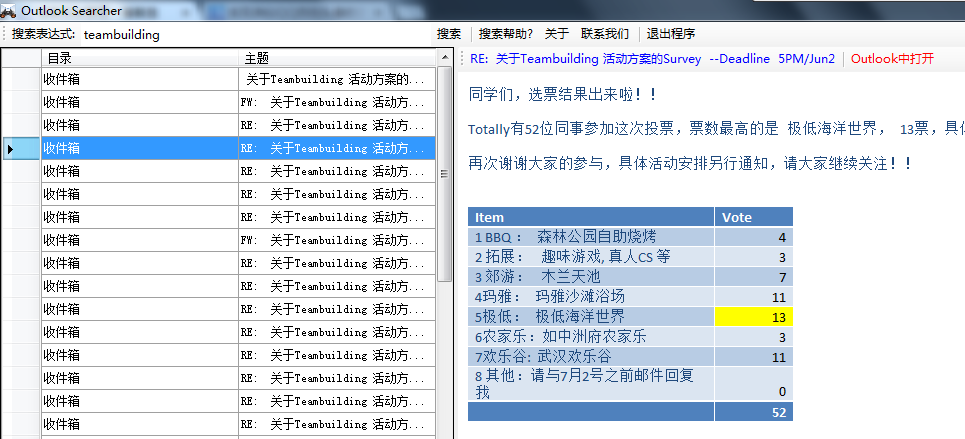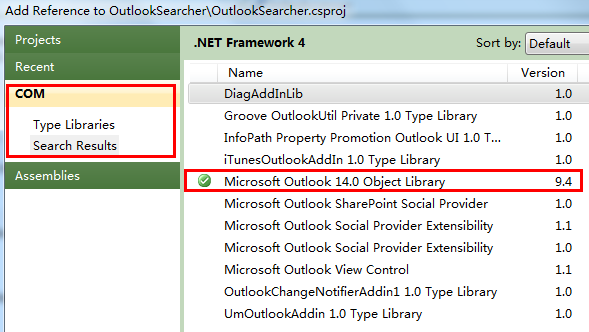C#编程大幅提高OUTLOOK的邮件搜索能力!

使用OUTLOOK, 你有没有遇到过上图的问题? 多达18419封邮件! 太多了, 每次想找一个邮件都非常耗时, 想办法解决这个问题成了一件非常紧迫的事情. 利用MS Search当然可以, 但是它太heavy了, 而且不支持如逻辑搜索表达式等复杂查找功能, 怎么办? 幸运的是我有WEBUS2.0 SDK, 于是我决定自己开发一个名为Outlook Searcher (Outlook搜索精灵) 的小工具.

Outlook搜索精灵主要包含两个功能:
1. 读取Outlook中的邮件信息并创建全文索引;
2. 提供搜索功能, 支持各种复杂的逻辑表达式.
先看看如何读取Outlook:
引用COM组件:

我这里引用的是9.4版本. 对应Outlook2010. 然后添加访问Outlook的代码:
using Outlook = Microsoft.Office.Interop.Outlook; ... Outlook.Application OutlookApp; Outlook.NameSpace OutlookNS; Outlook.MAPIFolder Inbox; Outlook.MAPIFolder Sentbox; ... void InitOutlookApp() { if (OutlookApp == null) { OutlookApp = new Outlook.Application(); OutlookNS = OutlookApp.GetNamespace("MAPI"); Inbox = OutlookNS.GetDefaultFolder(Outlook.OlDefaultFolders.olFolderInbox); //获取默认的收件箱 Sentbox = OutlookNS.GetDefaultFolder(Outlook.OlDefaultFolders.olFolderSentMail); //获取默认的已发邮件 } }
Outlook以Folder的方式来管理收件箱, 发件箱, 已发邮件等. 一般情况下, 我们接收的邮件都在"收件箱"中, 发出的邮件都在"已发邮件"中, 因此我们从这两个文件夹中获取邮件信息. 为了更加方便使用, 我创建了一个MailInfo类型来存放需要索引的邮件内容:
public class MailInfo { public string EntryId { get; set; } public string Folder { get; set; } public string From { get; set; } public string Subject { get; set; } public string ConversationId { get; set; } public string Body { get; set; } public string To { get; set; } public Document ToDoc() { var doc = new Document(); doc.Fields.Add(new Field("EntryId", this.EntryId, Webus.Documents.FieldAttributes.None)); doc.Fields.Add(new Field("Folder", this.Folder, Webus.Documents.FieldAttributes.Index)); doc.Fields.Add(new Field("From", this.From, Webus.Documents.FieldAttributes.Index)); doc.Fields.Add(new Field("Subject", this.Subject, Webus.Documents.FieldAttributes.AnalyseIndex)); doc.Fields.Add(new Field("ConversationId", this.ConversationId, Webus.Documents.FieldAttributes.Index)); doc.Fields.Add(new Field("Body", this.Body, Webus.Documents.FieldAttributes.AnalyseIndex)); doc.Fields.Add(new Field("To", this.To, Webus.Documents.FieldAttributes.Index)); return doc; } public MailInfo() { } public MailInfo(Document doc) { this.EntryId = doc.GetField("EntryId").Value.ToString(); this.Folder = doc.GetField("Folder").Value.ToString(); this.From = doc.GetField("From").Value.ToString(); this.Subject = doc.GetField("Subject").Value.ToString(); this.ConversationId = doc.GetField("ConversationId").Value.ToString(); this.Body = doc.GetField("Body").Value.ToString(); this.To = doc.GetField("To").Value.ToString(); } }
它还兼具了Mapping的功能, 能够在MailInfo和Webus.Document之间进行转换. 并且为每个字段都设定了索引选项. 现在一切就绪, 只欠东风了. 废话少说, 直接上代码:
先创建索引对象:
IIndexer IndexAccessor = null; ... private void frmOutlookSearcher_Load(object sender, EventArgs e) { ... this.IndexAccessor = new IndexManager(new MailAnalyzer()); //用MailAnalyzer作为分析器 this.IndexAccessor.MaxIndexSize = int.MaxValue; //索引大小无限制 this.IndexAccessor.MinIndexSize = int.MaxValue; //索引大小无限制 this.IndexAccessor.MergeFactor = int.MaxValue; //不做merge ... } ... private void IndexProc() { IndexAccessor.OpenOrNew(AppDomain.CurrentDomain.BaseDirectory + @"Index"); //索引数据放在运行目录的"Index"文件夹里面 ... //读取outlook, 添加文档到索引 ... }
再循环读取邮件并添加索引文档:
while(...) { //先读取inbox for (; InboxIndx <= Inbox.Items.Count; InboxIndx++) { ... this.InitOutlookApp(); var item = Inbox.Items[InboxIndx]; if (item is Outlook.MailItem) //注意, 并非每个inbox的item都是mailItem, 因此要做个类型检查, 否则程序会挂起, 死在那儿. { Outlook.MailItem mailItem = item as Outlook.MailItem; var mailInfo = new MailInfo() { EntryId = string.IsNullOrEmpty(mailItem.EntryID) ? string.Empty : mailItem.EntryID, From = string.IsNullOrEmpty(mailItem.SenderEmailAddress) ? string.Empty : mailItem.SenderEmailAddress, ConversationId = string.IsNullOrEmpty(mailItem.ConversationID) ? string.Empty : mailItem.ConversationID, Subject = string.IsNullOrEmpty(mailItem.Subject) ? string.Empty : mailItem.Subject, Body = string.IsNullOrEmpty(mailItem.HTMLBody) ? string.Empty : mailItem.HTMLBody, Folder = string.IsNullOrEmpty(Inbox.Name) ? string.Empty : Inbox.Name, To = string.IsNullOrEmpty(mailItem.To) ? string.Empty : mailItem.To }; IndexAccessor.Add(mailInfo.ToDoc()); //添加文档到索引 } ... } ... //再读取sentbox for (; SentboxIndex <= Sentbox.Items.Count; SentboxIndex++) { ... } }
最后将IndexProc放到后台线程中运行来提高用户体验:
private void frmOutlookSearcher_Load(object sender, EventArgs e) { ... this.IndexAccessor = new IndexManager(new MailAnalyzer()); //用MailAnalyzer作为分析器 this.IndexAccessor.MaxIndexSize = int.MaxValue; //索引大小无限制 this.IndexAccessor.MinIndexSize = int.MaxValue; //索引大小无限制 this.IndexAccessor.MergeFactor = int.MaxValue; //不做merge ... IndexingTask = Task.Factory.StartNew(this.IndexProc); //在后台线程编制索引 }
OK, 大功告成! Outlook搜索精灵支持如下搜索字段:
| 字段 | 类型 | 描述 |
| Subject | string | 邮件标题 |
| Body | string | 邮件正文, HTML格式 |
| Folder | string | 邮件所属目录, 比如"收件箱", "已发邮件"等 |
| From | string | 发件人 |
| To | string | 收件人 |
| ConversationId | string | 会话ID |
默认情况下, Outlook搜索精灵会使用
Subject="{0}" OR Body="{0}"
进行搜索, {0}会被自动替换成输入的关键词. 但是如果我们输入的本身就是一个搜索表达式, 那么Outlook搜索精灵会自动切换成高级搜索模式, 用用户输入的表达式进行搜索.
列举几个高级搜索的例子:
//1. 搜索标题含有"张三"并且正文含有"朋友聚餐"的邮件: Subject="张三" & Body="朋友聚餐"
//2. 在已发邮件中搜索标题中含有"张三"的邮件: Folder="[已发邮件]" AND Subject="张三"
//3. 搜索标题包含"Hotfix"的邮件: (hotfix和hotfixing都会被搜索到) Subject WILDCARD "hotfix"
这只是部分例子, 有了WEBUS2.0 SDK的支持, Outlook搜索精灵可以轻松实现7种不同类型的搜索, 并且支持复杂的逻辑搜索表达式, 具体请看 WEBUS2.0 In Action - 搜索操作指南 - (2).
为了让Outlook搜索精灵根据体贴好用, 我还设计了一些小功能, 比如Outlook连接中断自动重连, 最小化到托盘等. enjoy吧!
相关信息及WEBUS2.0 SDK下载:继续我的代码,分享我的快乐 - WEBUS2.0
